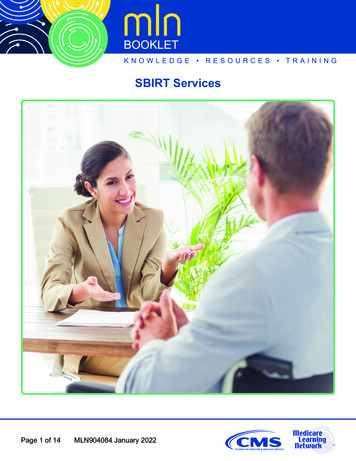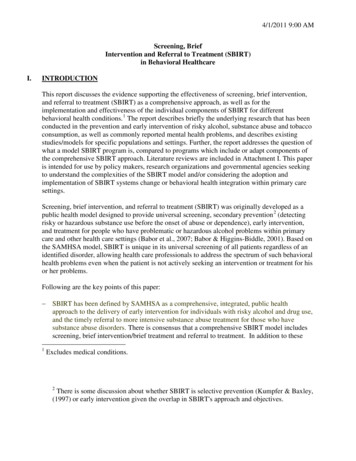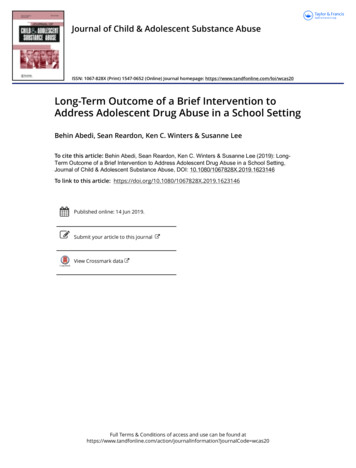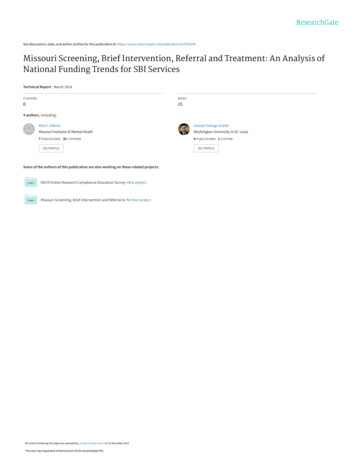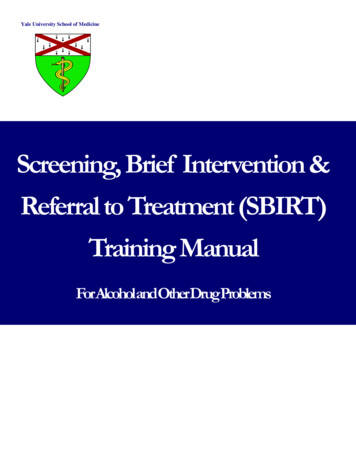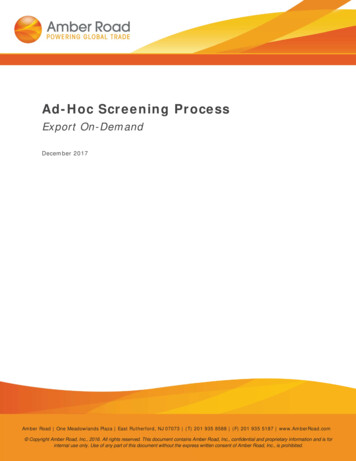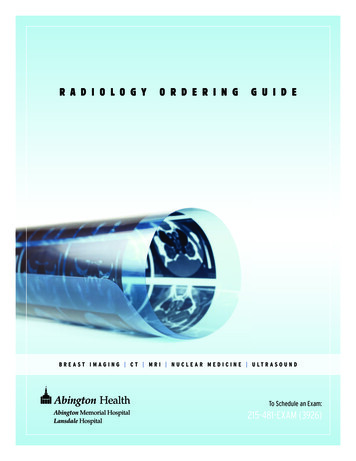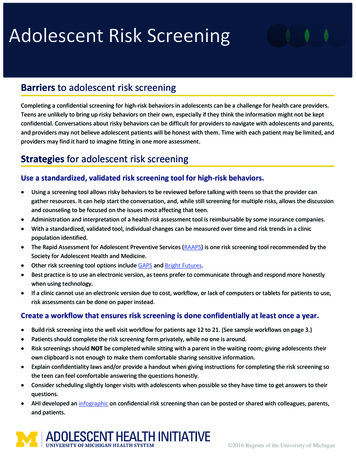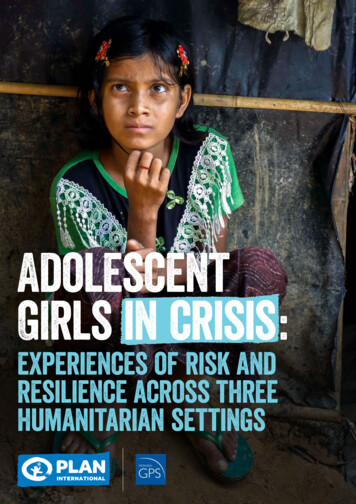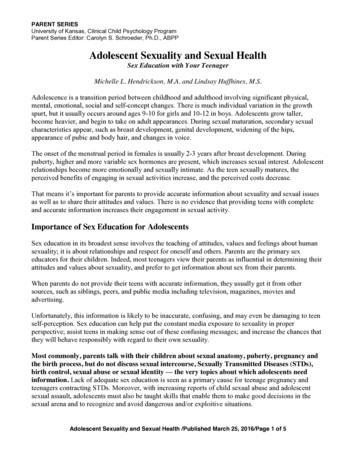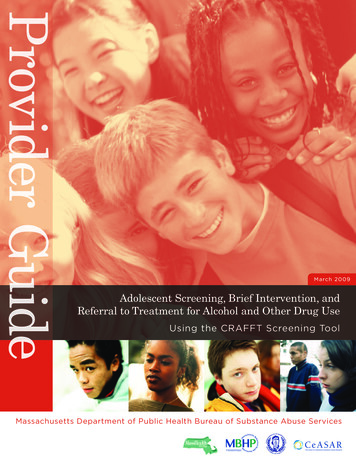
Transcription
Provider GuideMarch 2009Adolescent Screening, Brief Intervention, andReferral to Treatment for Alcohol and Other Drug UseUsing the CRAFFT Screening ToolMassachusetts Department of Public Health Bureau of Substance Abuse Services
Provider GuideTable of ContentsThe problem of adolescent alcoholand other drug usePage 2The CRAFFT Screening ToolPage 3Brief advice/interventionPage 8Referral and follow upPage 13Stopping substance abusebefore it startsPage 16Appendix A: CRAFFTScreening QuestionsPage 18Appendix B: Contract for LifePage 19Appendix C: Abstinence ChallengePage 20CRAFFT AlgorithmBack Cover
1Welcome adolescentprimary care providers!Research shows that many health careproviders feel that they have inadequate tools,training, time, and treatment resources foralcohol and other drug use screening and briefintervention for all adolescent patients.1Because physicians are uniquely positioned to influence adolescentsubstance use, the American Academy of Pediatrics recommends thatpediatricians provide alcohol screening and counseling to all adolescents,as well as children in upper elementary grades.2,3 Additionally, MassHealthnow requires primary care providers to offer to complete the behavioralhealth screening component of Early and Periodic Screening, DiagnosisFor more informationabout specific drugsand Treatment (EPSDT) and the Preventive Pediatric Healthcare(including prescriptionScreening and Diagnosis (PPHSD) well child visits for MassHealthmedications that canmembers under the age of 21 using an age-appropriate, standardizedbe abused), commonly-behavioral health screening tool selected from a menu of tools approvedused names, and healthby MassHealth.The menu includes the CRAFFT (CAR, RELAX, ALONE, FORGET,FRIENDS, TROUBLE) for adolescents aged 14 and older. The CRAFFT,effects, please referencewww.drugabuse.the featured screening tool in this guide, is a series of 6 questionsgov/DrugPages/developed to screen adolescents for high-risk alcohol and other drug useDrugsofAbuse.html,disorders simultaneously.from the NationalMassHealth also requires providers to provide or refer members toassessment, diagnosis, and treatment services if the standardizedbehavioral health screen indicates that the member has a behavioralhealth need.This kit provides the resources you will need to efficiently incorporatethe CRAFFT, brief advice, and referrals for further evaluation andtreatment for alcohol and other drug use into routine adolescent visits.Institute on Drug Abuse.
2The Problem ofAdolescent Alcohol andOther Drug UseThe majority of adolescents have used alcohol or another drug by the timethey have reached 12th grade. Alcohol is the most commonly used drugamong adolescents4 and is responsible for more mortality and morbidity inthis age group than all other drugs combined.5 Use typically begins duringearly adolescence, with peak initiation during grades 7 through 9. By the12th grade, 80% of high school seniors report having used alcohol, 62%report having gotten drunk, and 31% report heavy episodic use.4Among adolescents who drink alcohol, 38% to 62% report having hadproblems related to their drinking,6 such as interference with work,emotional and psychological health problems, the development of tolerance,and the inability to reduce the frequency and quantity of use.coTobacofInScreening Case StudiesParents’ tobacco use is related to their children’s early tobaccouse, and puts them at greater risk for early substance use.Visit quitworks.org/children for free information to help families quit smoking.The case scenarios in this guide provide examples of the varying types ofadvice providers give and follow up they arrange based on an adolescent’sCRAFFT screening. While the cases provide some sample dialogues, werecommend that each provider use his/her own style when communicatingwith adolescents.The case scenarios in this Provider Guide are fictional and the associated photos are not intended to represent the person in the case scenario.
3The CRAFFT Screening ToolEvery adolescent should be asked yearly about use of alcohol anddrugs. An easy way to remember how to screen adolescents forpsychosocial problems is to use the mnemonic “HEADSS” (home,education and employment, activities, drugs [including tobacco andalcohol], sex, suicidality/depression) 8 psychosocial interview, whichis included in the American Medical Association’s “Guidelines forAdolescent Preventive Services.”9The most frequently used substance abuse screening tool inMassachusetts is the CRAFFT. The CRAFFT is a series of 6questions developed to screen adolescents for high-risk alcohol andother drug use disorders simultaneously. It is a short, effectivescreening tool meant to assess whether a longer conversation aboutthe context of use, frequency, and other risks and consequences ofalcohol and other drug use is warranted. (See Appendix A.)
4The CRAFFT is a MassHealth-approvedbehavioral health screening tool for use withchildren under the age of 21 and is recommendedby the American Academy of Pediatrics’Committee on Substance Abuse for use withadolescents. It was developed by modifyingpromising questions from longer screens (i.e.,qualify with “ever”; screen for drugs as well asalcohol), combining similar questions, and thenassessing concurrent validity to identify the bestquestions for identifying adolescents who needsubstance abuse treatment.10 The sensitivity ofthe CRAFFT is similar to the longer AUDITand POSIT tests’, and much greater than thatof CAGE (which is not recommended for usewith adolescents).11 The CRAFFT works equallywell for alcohol and drugs, for boys and girls,for younger and older adolescents, and for youthfrom diverse race/ethnicity backgrounds.Using the CRAFFT screening toolScreening using the CRAFFT begins by askingthe adolescent to “Please answer these nextquestions honestly”; reminding him/her of youroffice confidentiality policy; and then asking 3opening questions.During the past 12 months, did you:1. Drink any alcohol (more than a few sips)?2. Smoke any marijuana or hashish?3. Use anything else to get high?(“Anything else” includes illegal drugs, overthe counter and prescription drugs, andthings that you sniff or “huff”.)Figure 1:CRAFFT is a mnemonic acronym of first letters of key words in the 6 screening questions.The questions should be asked exactly as written.CHave you ever ridden in a CAR driven by someone (including yourself) who was“high” or had been using alcohol or drugs?RDo you ever use alcohol or drugs to RELAX, feel better about yourself, or fit in?ADo you ever use alcohol or drugs while you are by yourself, or ALONE?FDo you ever FORGET things you did while using alcohol or drugs?FDo your family or FRIENDS ever tell you that you should cut downon your drinking or drug use?THave you ever gotten into TROUBLE while you were using alcohol or drugs?
5John: A 19-year old young man presented to the school-based health center with flu-likesymptoms and the nurse practitioner asked the 3 CRAFFT opening questions. Johnreplied that he had used alcohol, marijuana, and other drugs during the past 12months. The nurse practitioner asked the CRAFFT questions and documentedthat John responded “Yes” to all 6 questions. She then called the coveringphysician to discuss how to respond to John’s CRAFFT total score of 6.If the adolescent answers “No” to all 3 openingquestions, the provider only needs to ask theadolescent the first question – the CAR question.If the adolescent answers “Yes” to any 1 or moreof the 3 opening questions, the provider asks all6 CRAFFT questions. (See Figure 1.)Each “Yes” response to the CRAFFT questionsis scored 1 point. Adolescents who report no useof alcohol or drugs and have a CRAFFT scoreof 0 should receive praise and encouragement.Those who report any use of alcohol or drugsand have a CRAFFT score of 0 or 1 should beencouraged to stop and receive brief adviceregarding the adverse health effects of substanceuse. A score of 2 or greater is a “positive” screenand indicates that the adolescent is at high-riskfor having an alcohol or drug-related disorderand requires further assessment. (See attachedCRAFFT algorithm at the end of this guide.)For a downloadable, self-administered version of the CRAFFT and to orderpocket-sized CRAFFT cards for office use, visit www.ceasar.org.You may wish to integrate the CRAFFT screening questions into your electronic healthrecord (EHR) template. Be sure to include the responses to the individual CRAFFT questionsin addition to the final assessment if relying on the EHR to capture the data. Speak to yourmedical records department about ensuring the confidentiality of these data in accordancewith federal regulations. (See Confidentiality section on page 16.)The CRAFFT in Spanish, Portuguese, Hebrew, French, Czech, Khmer, Russian,Vietnamese, Haitian Creole, Laotian, Chinese, and Japanese will be availableby June 2009 at www.ceasar.org.
6Sarah: A 14-year old girl presented for an annual physical examination required forparticipation in her school’s fall sports program. She completed the paper CRAFFTscreening questionnaire. She answered “No” to all 3 opening questions and“No” to the CAR question. The practice receptionist then placed thecompleted questionnaire in Sarah’s folder for her physician to review.Options for implementing screeningin your practiceThe CRAFFT tool can be administered indifferent ways, based on the needs of yourpractice and patients. A recent study assessingadolescents’ screening preferences found thatadolescents preferred filling out the paper orcomputer version of the CRAFFT themselvesversus having a provider ask them thequestions.12Option 2: The physician or nurse practionercan ask the opening questions and CRAFFTscreening questions of adolescent patients.Option 3: Another provider in the physician’spractice (e.g., nurse or physician assistant) canask the opening questions and the CRAFFTscreening questions of adolescent patients anddocument the responses in the adolescent’srecord to ensure appropriate assessment andintervention by the provider.Option 1: A clinic staff member can give eachadolescent a paper version of the CRAFFT(included in Appendix A and at www.ceasar.org),ask the adolescent to complete it in private andreturn it, and place the completed questionnaireinto the clinic chart. The provider can review theCRAFFT and then conduct further assessmentor facilitate intervention.Taylor: A 16-year-old girl previously diagnosed with Attention-Deficit/HyperactivityDisorder (ADHD), presented for a stimulant medication review and prescription refill.She completed a paper CRAFFT screening questionnaire indicating that she hadused both alcohol and marijuana but no other drugs during the past 12 months.She answered “No” to all of the CRAFFT questions. The physician reviewedthe completed questionnaire prior to taking an ADHD medication history.
7Marcos: A 17-year old boy presented to the clinic urgent care center with a leg injuryresulting from a fall down a flight of stairs. The physician asked the 3 CRAFFT openingquestions. Marcos replied “Yes” to the question about drinking alcohol. The physicianthen asked Marcos the 6 CRAFFT questions and Marcos answered “Yes” to 3. Hesaid he had ridden in a car with someone who had been drinking (CAR), that hesometimes drinks to feel better about himself or fit in with friends (RELAX),and that he had gotten into trouble once while drinking with his friends(TROUBLE). Marcos’ CRAFFT total score was 3.PrivacyIn order to maximize the effectiveness of theCRAFFT, consider methods to ensure the mosthonest responses. If administering a paperor computer-based CRAFFT, give it to theadolescent when s/he is not with parent(s) anda private place is available for completion. Ifadministered directly by the physician or otherstaff member, you may wish to ask the questionsduring a portion of the medical visit, such as thephysical examination, when the parent has leftthe room, or ask the parent directly to pleaseleave the room for a few minutes so that you canask their child confidential screening questions.Adolescents’ privacy needs may presenta challenge. In some cases, parents will notleave the room or allow the provider to screenthe adolescent in private. (See page 16 forinformation on laws and regulations regardingconfidentiality.) However, teens will frequentlynot answer honestly if you ask questions aboutuse of alcohol, drugs, or other disapprovedbehaviors when a parent is present. We thereforerecommend using a screening method (paperquestionnaire self-administration, otherprovider/staff screen) that affords the greatestprivacy. In most clinical settings, this will be thepaper questionnaire, which the adolescent willcomplete in private before the medical visit, anda clinic assistant will then place in the clinicfolder for review by the provider. We recommendusing a questionnaire that tells adolescentstheir answers will be kept confidential. However,adolescents who screen positive need furtherassessment, and providers may uncoverinformation during the assessment that presentsa safety risk (e.g., injection drug use, illegalbehaviors, ingestion of potentially fatal amountsof alcohol), and which they decide warrants areferral to treatment. Providers must informparents of safety risks and treatment referralsfor adolescents less than 18 years old, althoughwe recommend that they tell adolescents as soonas possible when this is necessary, and reviewwith the adolescent the exact information theyintend to disclose. Determining what constitutesa safety risk is a matter of the individualprovider’s clinical judgment and based onall available information, not the results of ascreening questionnaire alone.Although health care providers are generally aware of adolescents’ use of alcohol or drugs, theyseldom identify adolescents with problematic use, abuse, or dependence.The use of structured screening devices, such as the CRAFFT, would likely improve identificationof adolescents with substance-related pathology in primary care settings.7
8Brief Advice/InterventionBrief advice from a primary care provider is an importantcomponent of interventions shown to significantly decreaseinitiation of drinking and increase cessation rates for alcoholand marijuana use among adolescents.13Sarah responded “No” to the opening questions. The physician praised her for not usingalcohol or drugs and encouraged her to remain abstinent. The physician then askedSarah the CAR question, to which she responded “No.” Sarah’s score on the CRAFFTwas 0. She, therefore, required the lowest level of intervention. The physicianpraised her for making good decisions and advised her to avoid riding witha driver who had used alcohol or drugs. The physician documented detailsabout the screening in Sarah’s chart.
9Taylor responded “Yes” to the opening questions but had a CRAFFT scoreof 0. The physician concluded that Taylor was at medium-risk and decidedto give Taylor brief advice. The physician documented the details in Taylor’schart and made a note to follow up in 3 months at Taylor’s next ADHDmedication check.Adolescents who screen as high-risk (e.g.,CRAFFT score of 2 or more) should have furtherassessment to determine whether they havedeveloped dependence (addiction) to alcohol oranother drug. Adolescents who are high-riskusers but have not developed an addiction maybenefit from a brief intervention – 1 or 2 briefintervention sessions either conducted by aprimary care provider or allied mental healthprofessional to discuss the impact of drugs oralcohol on their lives or their futures.Motivational interviewing (or “ChangeTalk”) techniques can be helpful in assistingthe patient to resolve his/her ambivalencetowards the impact of using alcohol andother drugs. Change Talk is meant to be selfmotivating dialogue. Change is facilitated bycommunicating in a way that elicits the person’sown reasons for and advantages of change.14 Afull presentation of motivational interviewingtechniques that are used in brief interventionsis beyond the scope of this toolkit; interestedreaders can find a thorough discussion of thiscounseling style in Motivational Interviewing byW.R. Miller and S. Rollnick.Adolescents who have developed substancedependence will need specific treatment forsubstance use disorders and ongoing support,and in most cases will need a referral tospecialty care. However, in these cases a briefintervention may be helpful in order to motivatethe adolescent to get the help that s/he needs.The following intervention examples arebased on the adolescents’ responses to theopening questions and CRAFFT questions.A. Adolescent answers “No” to 3opening questionsEducational studies show positive effectsof praise and encouragement on studentbehaviors.15,16 For adolescents who answer“No” to the 3 opening questions, we recommendthat the provider offer praise for not usingand encouragement to remain abstinent(a 1- to 2-minute conversation).“I see that you have not used alcohol or any otherdrugs during the past year. I hope you are proudof yourself. That’s a smart decision. If it everchanges, I hope that you trust me enough to tellme. Alcohol and drugs are bad for your brain,which at your age is still developing. Alcohol canharm your liver, and smoked drugs, includingmarijuana, can hurt your lungs, stain your teeth,and give you bad breath. Alcohol and drugs arealso linked to sexual assaults and car crashes,which are a leading cause of death for teenagers.Please stay away from them and don’t ever getinto a car with someone who has been drinking orusing drugs.”– Robert Kossack, M.D., Chairman, Departmentof Pediatrics, Fallon Clinic at Plantation Street,Worcester, MA.If the adolescent then Answers “Yes” to CAR question, werecommend that the provider give theadolescent a copy of the Contract for Lifeand suggest that s/he bring it home tohis/her parents or other trusted adultand have a discussion about theirproviding a ride or “out” in unsafesituations (with no questions asked atthe time). (See Appendix B or www.sadd.org/contract.htm.)
10B. Adolescent answers “Yes” to 1 or moreopening questions; CRAFFT total scoreis 0 or 1:We recommend that the provider advise theseadolescents to stop using completely. (A 2- to5-minute conversation is usually sufficient.)Strategies to persuade adolescents to abstainfrom substance use should include statementsthat focus on the adverse health effects ofalcohol and drugs, although providers shouldfeel free to mention how their parents oryounger siblings might respond to finding outabout their use.“I see from your questionnaire that you haveused alcohol and marijuana during the past 12months but you haven’t yet had any seriousproblems resulting from their use. So nowwould be a great time to stop. As your doctor Iam concerned about your health. Alcohol andmarijuana are bad for the developing brain, andrecent scientific studies have linked marijuanause during the teen years with development ofdepression and psychosis. Drinking can increaseyour risk of getting seriously injured or killed, likein a car crash. Marijuana can damage your lungs,stain your teeth, give you bad breath, and yourstimulant medicine won’t work as well. Marijuanaalso directly interferes with learning andschoolwork. Please don’t make things harder foryourself, you deserve to do well and go to college.Smoking anything also decreases your endurancein sports and other fun activities. How would youfeel about stopping for a while and then checkingback with me to talk about how it’s going?”– John W. Kulig, M.D., M.P.H., Director, AdolescentMedicine, Tufts Medical Center Floating Hospitalfor Children, Boston, MA.Marcos responded “Yes” to the opening question about alcohol use,which prompted his physician to ask all of the CRAFFT questions.Marcos responded “Yes” to 3 of the CRAFFT questions (CAR, RELAX andTROUBLE), which signaled to the physician that he was at high-risk for havingan alcohol use disorder. The physician asked follow-up questions to learn moreabout Marcos’ drinking.“Tell me about your alcohol use.”Marcos said that he started drinking 3 yearsago, when he was 14. He drinks every Friday andSaturday night. He usually has 6 to 7 beers, thoughhe has 10 or more beers every once in a while. He hashad “blackouts” (i.e., episodes of anterograde amnesiaassociated with heavy drinking) and passed out fromdrinking on a couple of occasions. During those times,he slept over a friend’s house so his parents wereunaware of his heavy drinking.“Has alcohol/drug use caused youany problems?”Marcos said that he was drinking at a party whenthe police came. He ran out the back door so he wasnot arrested, but several of his friends were takento the police station and had to be picked up by theirparents. He also said that he was kicked off the schoolbasketball team because he brought a pint of vodkato a game.“Have you ever tried to quit drinking?”No. Marcos did not think his drinking was a problemand he never tried to quit.The physician delivered the following message:“I am concerned about your drinking. Kids whohave blackouts because of alcohol are at high-risk ofdeveloping alcohol dependence later in life. As yourdoctor, I advise you to stop drinking completely forthe sake of your health. I will ask Linda to schedule afollow-up appointment with me in 4 weeks so that wecan talk more about alcohol and how it affects you. Doyou think you could stop drinking until our next visit?Would you be willing to try?”Marcos agreed to abstain and signed an AbstinenceChallenge in front of the physician. The doctorgave Marcos a copy (See Appendix C) and Marcosscheduled a follow-up appointment with thephysician. The physician documented the detailsabout the screening and brief intervention in theadolescent’s chart.
C. Adolescent answers “Yes” to 1 or moreopening questions; CRAFFT score is 2 ormore (high-risk)An adolescent responding “Yes” to 2 or moreCRAFFT questions may have a serioussubstance use disorder and requires furtherassessment to determine: a) whether asubstance use disorder such as abuse ordependence is present, and b) an appropriateintervention strategy. The brief assessment andscheduling of a follow-up visit require less than15 minutes.The DSM-IV lists the following diagnosticcriteria for substance abuse and dependence:Substance abuse(1 or more of the following): Use causes failure to fulfill obligations atwork, school, home Recurrent use in hazardous situations(e.g., driving) Recurrent legal problems Continued use despite recurrent problemsSubstance dependence(3 or more of the following): Tolerance (need to use more to achievesame effect) Withdrawal (feeling sick if substance notavailable)* Substance taken in larger amount or overlonger period of time than planned Unsuccessful efforts to cut down or quit Great deal of time spent to obtainsubstance or recover from the effect Important activities given up because ofsubstance use Continued use despite harmfulconsequences* The marijuana (cannabis dependence withdrawal) abstinence syndrome manifestsas relatively mild physical symptoms (e.g.,headache) but more severe craving andpsychological distress, leading some youthto mistakenly believe that marijuana is notaddictive.To determine a diagnosis of abuse ordependence, the assessment should focus on theadolescent’s age of onset of use, pattern of recentuse, negative consequences of use, and attemptsto stop using. Three recommended questions toask are: “Tell me about your alcohol/drug use. Whendid you begin using? What is your use likenow?” “Have you had any problems at school, athome, or with the law?” If yes, “Were youdrinking or using drugs just before thathappened?” “Have you ever tried to quit? Why? How didit go? For how long did you stop? Then whathappened?”These questions are designed to encouragethe adolescent to speak about the negativeconsequences of alcohol or drug use in their ownexperience. Adolescents who report relativelyminor problems (such as problems with parents,minor problems with friends or at school, etc.)should be challenged to consider making achange. For example, an adolescent who reportsthat he quits smoking during basketball seasonbecause he plays better when he is not smokingmarijuana might respond to a statement suchas, “It seems that you have noticed smokingmarijuana affects your lungs and really slowsyou down. Moving forward, what would youlike to do about that?” Adolescents who agreeto make a behavioral change should be given afollow-up appointment to discuss the results oftheir efforts, and praised for any progress theymade, no matter how small. A contract such asan Abstinence Challenge (included in AppendixC) may be used to record the exact parametersof the agreement.Adolescents who report more seriousproblems, such as use of injected drugs, legaltroubles, significant drop in school performance,or associated mental health problems, shouldbe referred for a more thorough evaluationby a substance abuse specialist. Statementsof personal concern, caring, and empathysuch as, “I am really worried about you,”are recommended strategies for promotingbehavioral change. (See the Referral andFollow up section of the guide for referralinformation.)11
12John scored 6 on the CRAFFT, answering “Yes” to all of the questions. Becauseof his score, his physician considered him high-risk for substance abuse ordependence. During the assessment interview, the physician learned that Johndrinks 5 or more beers most Fridays and Saturdays and that he smokes marijuanaseveral times a day.John was arrested for drinking in a parked car.The police brought him to the station and had hisparents pick him up, but did not press charges. Johnquit drinking after the arrest. His parents told himhis grandfather had alcohol problems, which can runin families. However, he had no intention of stoppingmarijuana at this point. He knew marijuana coulddamage his lungs, but planned on quitting in thefuture. He did not believe that marijuana was anaddictive drug, and he believed he could quit at anytime he wanted to. He just didn’t want to quit now.The physician recognized that John was showingsigns of marijuana dependence, and that he wouldlikely need specialty treatment in order to motivatehim to quit and then to support him in his efforts toremain clean and sober. She knew that it could bedifficult to get John to accept a referral to treatment,though his openness suggested that he was, at leastin some ways, looking for help. She also recognizedthat John expressed ambivalence about marijuanause – he had thought about damage to his lungs, andhe planned to quit in the future. She decided to usehis own ambivalence to help motivate him to change.She said, “It sounds like you feel you really needmarijuana to relieve stress right now, but on the otherhand you are worried about the impact it might haveon your lungs. I agree with you that marijuana canhave a big impact on your health, and I would like youto see someone who could help you explore your useof marijuana and help you to quit when you want to.Would you be willing to go?”John again said that he did not need help to quit,he simply had no interest at this time. The physicianreiterated that the choice of when to quit would beup to him but a specialist may help him think moreabout how he was using marijuana and the impactof marijuana on his health. John agreed reluctantly.The doctor responded, “Good, I think that is a smartdecision. In the meantime, I would like to talk aboutsafety. Many kids don’t realize it, but it is verydangerous to drive after you smoke marijuana. Canyou contract with me never to drive after smokingor ride in a car with anyone else who had been usingalcohol or drugs?” John agreed and signed a Contractfor Life. (See Appendix B.)The physician knew that John was unlikely to followthrough with the referral on his own, and that hisparents would likely receive notification if he did entertreatment (i.e., insurance company explanation ofbenefits, or EOB form), so she asked his permissionto discuss it with his mother, who was in the waitingroom. The physician said that she would not discussthe details of his drug use and she would emphasizethe progress he has made. John said that his parentsalready knew that he drank alcohol and usedmarijuana. He gave his permission to discuss theirconversation.When John’s mother came in, the physician said,“John has been very honest with me about his alcoholand drug use. He has already decided to quit drinkingentirely and never to drive after smoking marijuana.He has agreed to accept a referral to speak with aspecialist about his marijuana use. I fully support all ofthese decisions, and I hope you do too. I will give bothof you the phone number to the referral office. I’d liketo see you back, John, after your appointment, so thatwe can talk about how it went.”The physician provided John’s mother with a copyof Alcohol and Other Drugs: Is Your Teen Using? Sheencouraged John’s mother to sign the Contract for Lifeas well. She also gave John a copy of the agreement,and Even If You Know about Drinking or Drugs:Simple Questions. Straight Answers. (See Referraland Follow up.)The physician documented the details of thescreening and brief intervention in John’s chart,scheduled an appointment for 4 weeks from thecurrent visit, and indicated that he would get backto John and his mother with information aboutthe referral.When talking to parents, encourage them to: Listen to their teen, even if it’s difficult Set limits and clear expectations Remove access to alcohol and drugs (e.g.,cash, cars, cell phones, computers) If products that could be used as inhalantsare available, always supervise their use Express the fact that they care about theiradolescent and his/her goals
13Referral and Follow UpSeveral resources exist for those patients that requirefurther assessment or substance abuse treatment and forprovid
The most frequently used substance abuse screening tool in Massachusetts is the CRAFFT. The CRAFFT is a series of 6 questions developed to screen adolescents for high-risk alcohol and other drug use disorders simultaneously. It is a short, effective screening tool meant to assess whether a longer conversation about
